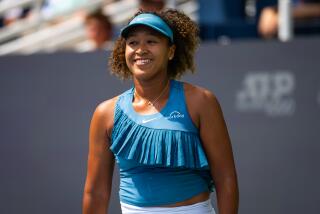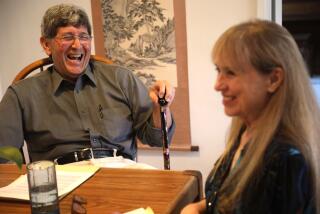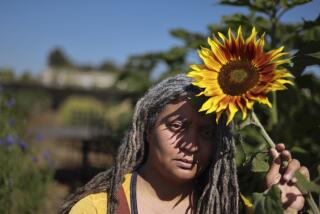Keeping Hope in the Family
Keeping Hope in the Family
For a dying cancer patient, a big brother who specializes in the disease lends support, expert advice and possibly a lifeline.
*
Although it’s been 40 years, Ken Tokita hasn’t forgotten those wet Seattle nights when he used to search the streets for his little sister so he could haul her out of trouble and drag her home.
“He didn’t always find me,” says Yaeko Namba with a mischievous grin.
Now 57 and a respected physician, Tokita is trying to haul his sister, 53, out of another kind of trouble. Namba is dying of cancer, and Tokita, a radiation oncologist, has devoted his life to fighting it.
“If anyone can help me, he can,” Namba says with beaming confidence.
Hope lies not only in his expertise, but also in his blood, a perfect match with hers and the blood of two of her four children. In a bittersweet coincidence, Tokita opened his own cancer center and launched a clinical research study aimed at helping people with all types of terminal cancer at precisely the time his sister needed such help. Two months ago, Namba became Tokita’s first study patient. Although long-term survival is unlikely, their hope is that Tokita can buy his sister, who has a rare cancer in her chest, and other cancer patients more quality time.
The siblings are sitting together in Tokita’s Palos Verdes living room, and the scene is not what you’d expect. She’s dying. He’s trying to save her. And they’re laughing.
They’re talking about the New Lucky Hotel in Seattle, not far from the original Skid Row. The hotel was a flophouse, actually, which their widowed mother owned. To support her eight children, she leased out rooms to transient tenants for 25 cents a night. The kids lived there too, in rooms with cracks in the walls so big you could see into the next room.
“The building was so rundown, it leaned over,” Tokita recalls. “When the big earthquake of 1953 hit, the building actually got straighter.”
And they’re laughing at the fact that Tokita was almost born in a barn. In 1942, while his parents were on their way to the Japanese internment camps, his family was taking refuge in a horse stall when Tokita’s mother went into labor. His parents made it to Tacoma Hospital, then went on to the internment camp in Idaho where they lived for four years. Yaeko, the last of the family’s eight children, was born the year the family got out of the camps. Their father, a sign painter, died two years later.
Although the family didn’t have much money, Tokita says, “we never suffered. We had a really good time and never felt that we were deprived of anything. Mother wouldn’t tolerate self-pity.”
Apparently, Namba had an especially good time.
“She really enjoyed life,” says Tokita, sharing a knowing look with his sister. He was the studious one, who knew from age 7 that he wanted to be a doctor. Some nights, while he was up studying, she would slip out the window of her ground-floor room and go carousing. During those free-spirit days, Namba started smoking, although her doctors aren’t certain that smoking caused her particular cancer.
Though she didn’t always appreciate her big brother’s “help” when he’d go looking for her, he was the one she turned to when she got in trouble.
“I feel very fortunate I have him to turn to now,” says the trim, spry woman whose only sign of illness is a wet-sounding cough and her short salt-and-pepper hair, which is growing in post-chemo.
From Doctor’s Office to the Hospital
For Namba, a wife, mother of four and grandmother of six, a new brand of trouble started last June. One morning, she left her Seattle office, where she worked as an AT&T; Wireless customer care representative, for an appointment with her primary-care doctor. The doctor had wanted to see her weekly because she didn’t like how Namba’s heart sounded. Namba had blamed her fatigue and bloating on menopause, and her shortness of breath on just another miserable cold.
That day, her doctor ordered a chest ultrasound, which showed a mass covering her heart. From the ultrasound room she was escorted to the hospital and by that evening was in cardiac failure. The biopsy revealed thymic cancer. The outlook wasn’t good.
“No one thought she’d make it out of the hospital,” recalls Pam Oyanagi, Namba’s daughter.
Knowing her time was short, Namba called her family to her bedside and asked her children if they had any last questions for her.
“They had a lot of questions,” she says, “and that was wonderful. It brought peace.”
Among their questions were these: Did we meet your expectations? “Yes,” she assured them. “You’re all happy.”
Are you afraid? “No. This is the course of my life. It’s God’s will.”
That same week, she got her affairs in order and made decisions on how to handle her remains.
“That was nine months ago,” she says with a laugh and a shrug that shows she knows she’s living on borrowed time.
“Which shows you how stupid it is to make predictions,” says Tokita, an assistant professor of radiation oncology at UCLA School of Medicine and an adjunct professor of cell biology at the Scripps Research Institute in La Jolla. “I always tell doctors, ‘Never predict. You’ll always be wrong.’ ”
Located just behind the breast bone and in front of the heart, the thymus gland is usually only active during infancy, when it’s the size of a baby’s fist and has the important job of creating T-cells, which help the body form immunities. If you could find the thymus in an adult, explains Tokita, it would be as thin as paper and about the size of a silver dollar.
Experts don’t really know how often thymic cancer occurs because it is so rare, but Tokita estimates the cancer affects about one in 10 million people.
“I’d personally never seen it before,” says Tokita, “because no one gets it except for Weirdo over here. At least you could have picked a cancer I knew how to treat,” he chides her. “You’ve been trouble ever since you were born.”
In her case, the mass has not only embedded itself in her heart, but also has spread to her lungs. Although the usual treatment for cancer that has spread is chemotherapy followed by radiation, doctors at Providence Hospital in Seattle decided, with Tokita’s OK, to start radiation treatment along with the chemo right away because Namba’s tumor was pressing on her heart.
Tokita kept in touch with the Seattle physicians by phone and talked to Namba’s children.
“He gave us frank answers and guided us through what we should expect both medically and as a family,” Oyanagi says.
Namba did make it home, thanks to excellent treatment from her team, who relied heavily on Tokita’s phone consultations. But her health prevented her from going back to work, and she had to go on disability.
Brother Readies Research Center
Meanwhile, Tokita was putting the final touches on the Tokita Radiation Treatment Center in Irvine, a cancer center affiliated with Irvine Regional Medical Center, which opened in January. He was also getting ready to launch his clinical study the very week Namba’s doctors told her there was nothing more they could do.
“It was as if all the pieces of the puzzle came together as they were meant to,” Namba says.
Although he does feel frustrated at times by the limits of both his ability and of medicine, more often he feels grateful for what he can do.
“It’s a good thing for Yaeko that long ago I got over the fact that God wouldn’t let me cure everyone,” he says. “God doles out tools one by one, and I have [a tool] now that I really need.”
Tokita’s research is based on his theory that as people age, their immune systems get weaker, which is why older people get more cancer. Immune cells act as surveillance systems against cancer cells. Tokita and his colleagues believe younger, healthier immune systems fight cancer cells better. To date, many cancer specialists working in immunotherapy have tried to boost cancer patients’ immune systems by using the patients’ own white blood cells, reproducing them in a lab and putting them back in the body.
But, reasons Tokita, the patient’s immune system is already defective, so more of a failing system doesn’t work. He believes a better approach might be to get white blood cells from a younger relative who is a blood match.
“Then maybe the new cells can recognize the enemy and attack,” he says.
Four years ago, while working at St. John’s Hospital and Health Center in Santa Monica, Tokita tested this theory on 25 patients who had end-stage cancer. One-third had a positive response: Their tumors shrank, they went into remission and their health improved. Another third stayed about the same, and the final third worsened as they would have without treatment. The study was repeated on 400 patients at Houston’s M.D. Anderson, one of the most well-regarded cancer hospitals in the nation, with the same results.
Now he’s fine-tuning the study and hopes to include 30 participants in the second phase of his trial. (To qualify, patients have to be declared terminal and have to have exhausted all traditional courses of therapy.)
In February, Oyanagi, 31, flew down from Seattle with her mother so Tokita could extract her white blood cells and give them to Namba. Right away, her mother felt better, and a certain marker in her blood that rises in the face of tumor activity went down--a good sign.
“Mom was so much better,” Oyanagi says. “She looked healthier and was her energetic self again. She wanted to go shopping and to hockey games, and she had all the grandchildren over on Sundays like usual.”
If she hadn’t had the treatment, Tokita said, “she’d probably still be here but would be much sicker.”
If her condition starts to wane again, they will try Tokita’s blood next, and although his blood won’t have the advantage of youth, it is a perfect match with his sister’s.
The Goodbyes Are Said, but Life Goes On
Now that she’s said all her goodbyes and gotten her affairs in order, Namba finds living a bit awkward. Not that she isn’t grateful, but, she said, “it’s hard when you’ve outlived your expected range.” She’s not healthy enough to return to work, and her friends and acquaintances don’t quite know what to say around her. As a result, her social circle has grown much smaller.
“When you face something like this, you know instinctively who you want in your world.” In this case, it’s her family and a couple of close friends. “They don’t treat me like there’s something wrong. We’ve talked and brought closure, so they’re OK with [the situation], but they’re not overprotective. We can carry on normally.”
Despite the uncertainty, she looks ahead: “The more plans I make, the more targets I hit.” Right now, plans include a trip in May to Reno with her husband, her nephew’s wedding in October and her daughter’s 21st birthday in November.
Although Namba and her family remain upbeat and feel blessed that Tokita is in a position to help, they’re also realistic.
“She most likely won’t survive this,” Tokita says. “But that doesn’t mean we can’t do anything. The chance of cure is zero to minus 10. . . . I’m only a doctor.”
He’s not grandiose enough to believe his research will cure cancer, but he’s not completely jaded either. “If we can make people better for a while--improve the quality of their life and extend it, that’s a small step. And 99% of medical research is about such steps,” he says. “Every doctor starting out dreams of curing the disease he is trained to treat. In the back of my mind, there was this flicker that I wanted to cure cancer in a nondestructive way. Now we cure some cancer, but how? We burn. We cut. We poison. There are huge side effects. The dream is to cure without harm.”
“No one knows what will happen,” Namba says. “I may have a week or a year. I’m grateful for whatever. But if Ken and his colleagues can learn something from my case and turn this situation into one that serves others, that’s great too.”
“Despite what she says,” Tokita says, “I learned a lot from my sister.” At this, Namba laughs again. “And I still am,” he adds.
More to Read
Sign up for Essential California
The most important California stories and recommendations in your inbox every morning.
You may occasionally receive promotional content from the Los Angeles Times.










